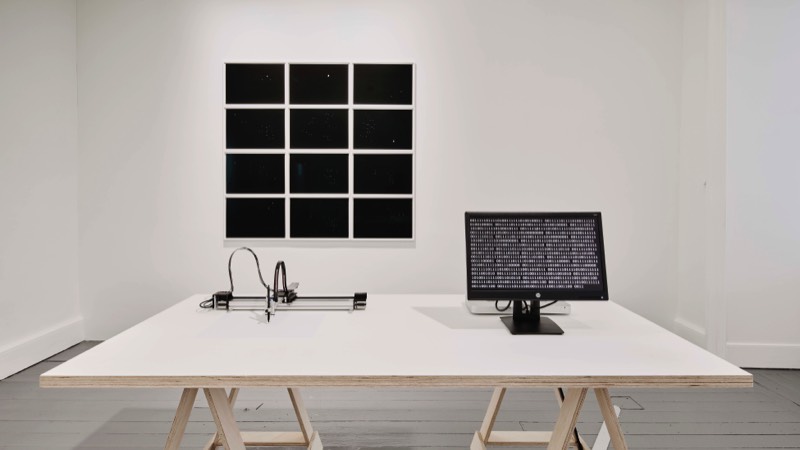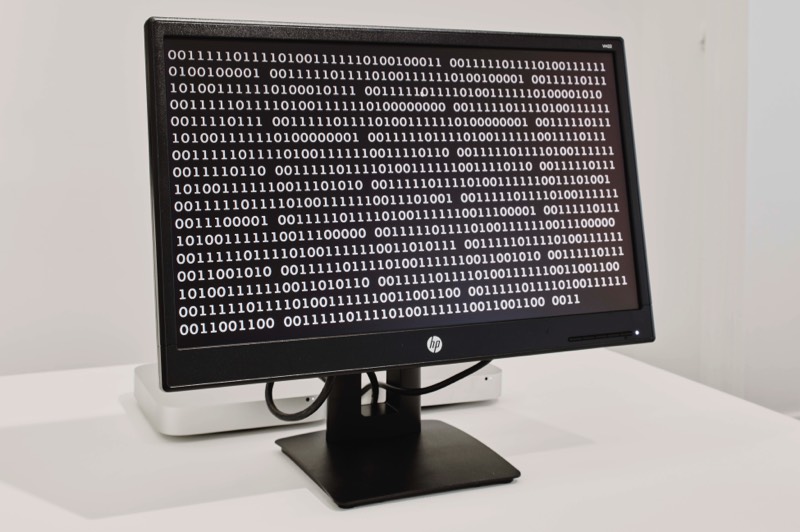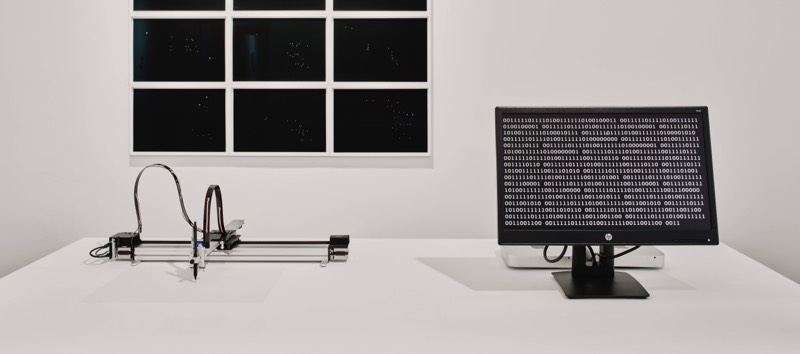





MORNING STAR, EVENING STAR, 2019 Plotter, computer, monitor, paper, table
42 x 29.7 paper, installation dimensions variable
In the fourth room of the exhibition, we see the work Morning star, Evening star. On the table in the centre of the room are a drawing plotter and a computer monitor.The plotter is drawing in real time the transit of the planet Venus through space.
After 8 years,Venus returns to the same place in the sky on the same date, creating an intricate circular pattern whose key points contain the markings for a pentagram or a five point star.Articulating its complex movement from the perspective of the Earth, the pattern created is referred to as the Venus Rose. The drawing will be rendered visible by the use of a line plotter,an early graphic device which creates a consistent line and unlike a printer, enables the entire process to be visible as it draws in real time the complex path of the planet as it circumnavigates the heavens.
The computer monitor on this table displays the transit of Venus translated to binary code, in synchronisation with the drawing. These two radically different visualisations of the same information reflect the fact that Venus was once thought to be two different stars, appearing in the morning and the evening. The work reflects this idea of the potential of multiple identities or concepts held within one entity.
Frege in his essay 'On sense and reference' begins by explaining the cognitive value of identity statements such as the 'The Evening Star is the Morning Star’ with regard toVenus.The distinction between sense and reference was an innovation of Frege in 1892, reflecting the two ways a singular term may have meaning.The identity between the first star we see in the evening and the last star we can see in the morning was an empirical discovery in astronomy, a piece of information that was not available by means of semantic analysing, for it is not contained in the meaning of the term used to describe the heavenly body that appears in the evening and in the morning (not a star but the planet Venus as it turns out). Frege argued, we need to recognise that meaning is a broad semantic category with multiple dimensions, and we need to develop fine- grained distinctions to identify the different semantic ingredients that make up the meaning of a term.
The Venus Rose has had broad cultural references over different periods in history. In a typical Renaissance fashion, Heinrich Cornelius Agrippa and others perpetuated the popularity of the pentagram as a magic symbol, attributing the five neoplatonic elements to the five points. However by the mid-19th century a further distinction had developed amongst occultists which depended on the pentagrams orientation. With a single point upwards it depicted the spirit presiding over the four elements of matter, reportedly signifying the five wounds of Christ.Whereas the influential writer Eliphas Levi declared it as a symbol of evil, whenever it appeared the other way, as a reversed pentagram, with two points projecting upwards, because it overturned the proper order of things and demonstrated the triumph of matter over the spirit.
Sometimes referred to as the Morning Star,Venus the brightest star in the heavens may be seen as a contradiction to being a symbol of Lucifer, but the role of Lucifer is complex and should not exclusively be depicted as a horned beast. Jan Verwoert in his essay ‘Bring on the Devil’ discusses how the devil was embraced by the Romantics poets such as Baudelaire and Byron whose views in turn were shaped by John Milton’s ‘Paradise Lost’. Milton articulates Satan as the fallen but rebel angel and in doing so constructed him as the idol of the outlawed and as such the devil has become a prime source of identification for many different performers on the social stage of culture, a romantic role model for poets, artists, divas, dandies and disaffected teenagers.
Installation at the Irish Museum of Modern Art
In the fourth room of the exhibition, we see the work Morning star, Evening star. On the table in the centre of the room are a drawing plotter and a computer monitor.The plotter is drawing in real time the transit of the planet Venus through space.
After 8 years,Venus returns to the same place in the sky on the same date, creating an intricate circular pattern whose key points contain the markings for a pentagram or a five point star.Articulating its complex movement from the perspective of the Earth, the pattern created is referred to as the Venus Rose. The drawing will be rendered visible by the use of a line plotter,an early graphic device which creates a consistent line and unlike a printer, enables the entire process to be visible as it draws in real time the complex path of the planet as it circumnavigates the heavens.
The computer monitor on this table displays the transit of Venus translated to binary code, in synchronisation with the drawing. These two radically different visualisations of the same information reflect the fact that Venus was once thought to be two different stars, appearing in the morning and the evening. The work reflects this idea of the potential of multiple identities or concepts held within one entity.
Frege in his essay 'On sense and reference' begins by explaining the cognitive value of identity statements such as the 'The Evening Star is the Morning Star’ with regard toVenus.The distinction between sense and reference was an innovation of Frege in 1892, reflecting the two ways a singular term may have meaning.The identity between the first star we see in the evening and the last star we can see in the morning was an empirical discovery in astronomy, a piece of information that was not available by means of semantic analysing, for it is not contained in the meaning of the term used to describe the heavenly body that appears in the evening and in the morning (not a star but the planet Venus as it turns out). Frege argued, we need to recognise that meaning is a broad semantic category with multiple dimensions, and we need to develop fine- grained distinctions to identify the different semantic ingredients that make up the meaning of a term.
The Venus Rose has had broad cultural references over different periods in history. In a typical Renaissance fashion, Heinrich Cornelius Agrippa and others perpetuated the popularity of the pentagram as a magic symbol, attributing the five neoplatonic elements to the five points. However by the mid-19th century a further distinction had developed amongst occultists which depended on the pentagrams orientation. With a single point upwards it depicted the spirit presiding over the four elements of matter, reportedly signifying the five wounds of Christ.Whereas the influential writer Eliphas Levi declared it as a symbol of evil, whenever it appeared the other way, as a reversed pentagram, with two points projecting upwards, because it overturned the proper order of things and demonstrated the triumph of matter over the spirit.
Sometimes referred to as the Morning Star,Venus the brightest star in the heavens may be seen as a contradiction to being a symbol of Lucifer, but the role of Lucifer is complex and should not exclusively be depicted as a horned beast. Jan Verwoert in his essay ‘Bring on the Devil’ discusses how the devil was embraced by the Romantics poets such as Baudelaire and Byron whose views in turn were shaped by John Milton’s ‘Paradise Lost’. Milton articulates Satan as the fallen but rebel angel and in doing so constructed him as the idol of the outlawed and as such the devil has become a prime source of identification for many different performers on the social stage of culture, a romantic role model for poets, artists, divas, dandies and disaffected teenagers.
Installation at the Irish Museum of Modern Art